An angler can have all the right gear, have all that gear set up correctly, and still only get lucky out on the water. The ability to recognize ideal zones that offer a fish the food source and safety that it requires will give the angler an advantage every time. Here are some distinguishing characteristics of these feeding lies that to look for when approaching the water.
Rivers and Streams
It is important to remember that not all fish are always feeding, and not all water is good water to fish. When looking for fish, look for active fish, ones that are swinging back and forth in a current as opposed to one that is sitting on the bottom. Fish do rest, and in the resting position, they won’t be feeding. Typically, a resting fish will be in water that is not great water to focus on as the feeding fish have moved from that water into their feeding lies. For example, during a hatch, it is common for fish to move out of the deep pool and into the shallower riffles above the pool. Many times, the fish still in the pool will be resting and focusing fishing efforts on the riffles and drop off upstream will be better. Don’t get caught up beating dead water just because there is a visible fish sitting on the bottom of it, instead look for the more ideal feeding lies holding the active fish.
Seams
A seam is considered any point at which two currents come together to eventually form one current, but may run at different speeds for some time. It is a perfect feeding lie for a fish as each current will carry food to the fish and each side of the seam may have a different food source or speed in which the fish prefers. Often times, a seam will be distinguished by a line of bubbles or foam, commonly known as the “bubble line.”
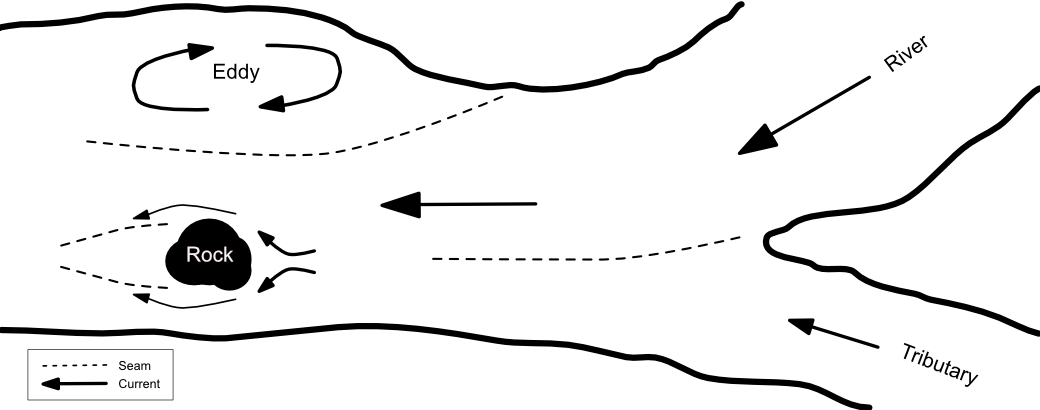
Some seams are more defined than others, such as when a tributary stream meets with a larger river and some can be smaller such as in pocket water as currents flow around boulders and meet again downstream of them. Seams will also occur along the outer edge of an eddy where the main current flows past the eddy and along river bends as the fast current on the outside flows along the slow currents on the inside of the bend.
Fish will often sit in on one side of the seam, but feed in both sides, swinging back and forth to grab food and move back to the more comfortable side of the seam.
Riffles and Pools
Some more obvious places to look for fish are in the common river structures that involve a deeper pool, with a riffle and a drop off above it. These are easily recognized by the small rolling waves that dwindle in to a flat-water area where the water is deeper. Fish will gather and hold in the deep water, the pool, where they can easily go deep for safety, but have plenty of room to feed as well. Fish in this area can be more selective as they have more time to inspect the food source prior to eating it.
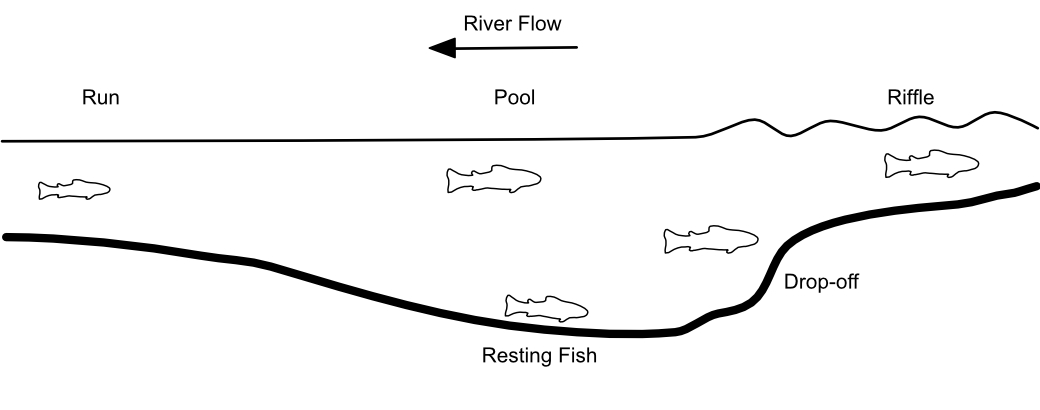
When insects are actively hatching, fish will often move upstream from the deep water and into the shallower riffles above the pool where food is more congested into a small area. When fish are found in these riffles, and not during spawning season, they will be the active feeding fish and are opportune targets. If fishing during spawning season, observe these fish for some time to be sure they are not spawning, or even sitting on a spawning bed prior to fishing and never interrupt spawning fish!
Also during a hatch, but even without a hatch, an angler can find feeding fish just below the drop off where the riffle leads into the pool. A fish holding just below the drop off has a faster escape to deep water for safety, but also captures the opportune feeding lie of the shallower, riffle water. These drop-offs can often be found as mere depressions withing the stream, but can be difficult to see. The discerning angler will pick these out by noticing the color change in the water as the deeper water turns darker than the surrounding shallow water.
Remember, it is always a good idea to approach these areas from downstream as to not spook any fish in the slower water of the pool, whom may spook the fish above.
Structure
Structure within a water system is a term that can be used as generally as to describe a drop off or pool, but in a more strategic sense, it is used to define more prominent features like a boulder or log jam. Consider a log jam, or a fallen, submerged tree, this is structure that will offer great safety for fish, especially from predators from above. For that reason, fish will tend to stay close to this type of structure in order to feed safely. Once hooked, it seems that the fish always know to go directly to some sort of structure to wrap the angler’s leader around it and break free. While it may seem that their strategy was to wrap one’s leader around a branch, they are merely instituting a natural reaction to seek safety.
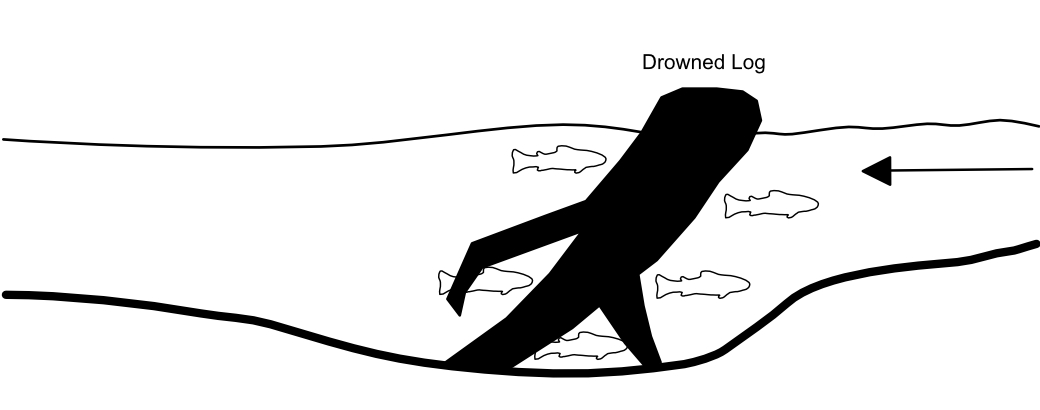
In the instance of a log jam, fallen tree, or old tree stump in the river, a fish has many places to sit with protection from above. Obviously, this type of structure creates a real problem for the angler as the flies will be more than capable of snagging up in the structure before being eaten by a fish. Once hooked, they will often dive deeper into the tangled mess of branches.
Another form of structure, and one that offers a superior fishing opportunity than the log jam is a midstream boulder. A midstream boulder, especially when not fully submerged creates multiple feeding lies for a fish. In front of the boulder, a type of pillow forms as the current deflects off of the boulder where a trout can easily hold and collect food. Behind the boulder will be a pocket that is an ideal holding place for a trout as it can collect food in the pocket as well as both seems as the current flows around the pocket. While holding in a pocket, remember that a fish may be facing just about any direction.
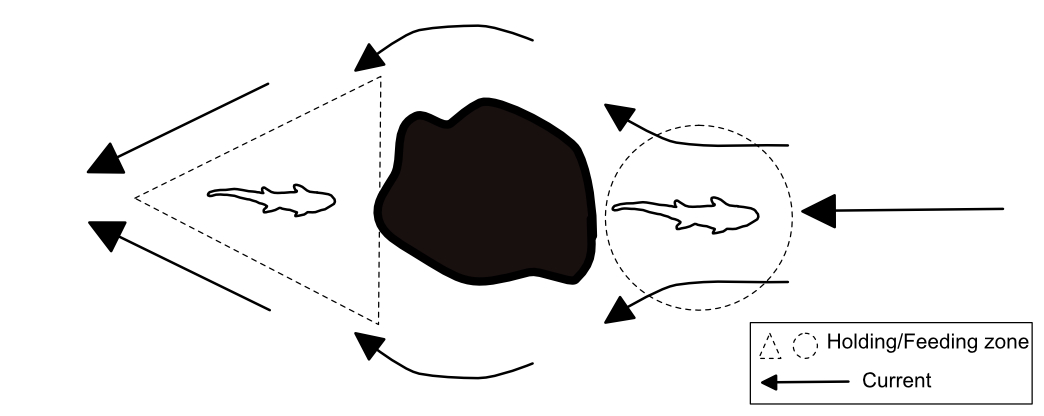
River Bends
A bend in the river will typically present an angler with two main target areas, the undercut bank, and the seam at which the inner and outer currents meet. It is usually best to approach a bend in the river from the inside of the bend, and from downstream to avoid alerting the fish by sight or sound.
The undercut bank is formed on the outside of the bend as the water runs along and erodes the bank. A deep enough undercut can provide a feeding lie for a fish where it is completely hidden from above, but still has a constant flow of food. While this is a great place for a fish, it poses a tough drift for the angler as the best drift is achieved by standing on the outer bank, on top of the undercut. By walking along the undercut bank though, the vibration from above will usually spook the fish form it’s feeding lie underneath. Walking along the outside of the bend also gives the angler a better vantage point to spot fish, but will still risk spooking them before getting a chance to catch them.
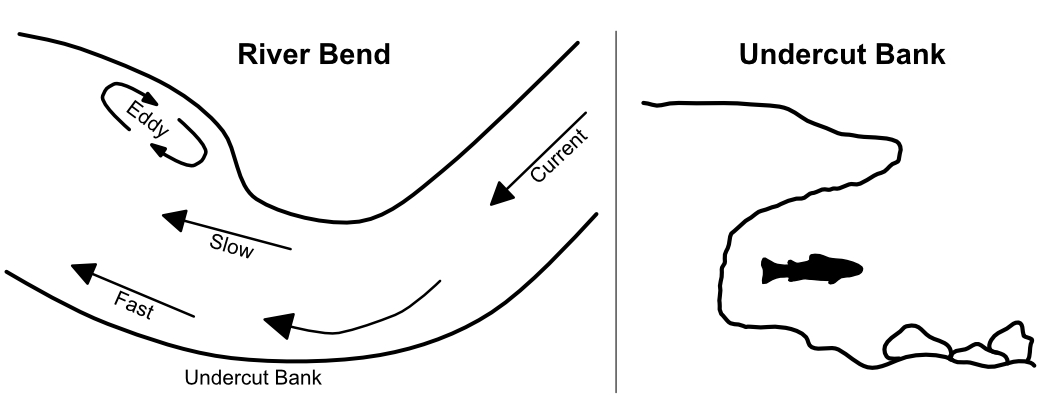
When approaching a river bend from downstream, and the inside of the bend, begin fishing by targeting the seam between the slow current inside, and the main current. Only begin moving across the river towards the cutbank after fishing that seam and the main current first. In larger rivers and streams, there may be an eddy on the inside of the bend along the upper section of the bend as well.
Eddies
An eddy is a section of water in which the water is circling back upstream due to an obstruction above that forced the main current away from the bank. Eddies occur below big boulders along the bank, and along the inside of river bends most commonly. These stream features offer fish a place to swim around lazily while collecting the food that has become trapped in the recirculating water.
Mats of foam often build up in the swirling water here which offer safety for fish as they are able to sit underneath the mat to be unseen from above. These mats of foam also trap food, making an easy meal for the fish underneath it.
Another feature of an eddy is that fast moving water carrying sediment will slow down once in the eddy and allow the sediment to fall. This is a type of sediment trap, which is why the river bottom in an eddy is typically soft, sandy, and difficult to wade through. One may find themselves shin deep in sediment while trying to wade through a large eddy so it best to not try sometimes.
Fish tend to be everywhere in a river or stream, but most of time, they can be found in the same features throughout every waterway. Having the ability to read the river and structure within it will make an angler more efficient each day on the water so spend time observing each stretch of river to identify the likely places for fish to sit before jumping right in.
Stillwater (Lakes, Ponds, Reservoirs)
Approaching a body of Stillwater, no matter how big or small, takes a different understanding of where to find fish than the approach to streams and rivers. While a fish is typically restricted to certain areas within a flowing waterway, in Stillwater, they can be just about anywhere. Fortunately, they do prefer certain areas of Stillwater that will be similar, if not the same throughout other bodies of still water.
First of all, water temperature is one of the most important aspects in understanding where trout will hang in stillwater. Trout have an ideal water temperature at which they will prefer, so finding the level of water that contains their ideal temperature should be the top of the priority list when searching for feeding trout. Keep in mind that the ideal temperature zone will change throughout the season as air temperatures go from cold in the spring to hot in the summer, then back to cold in the fall. A general rule of thumb is to assume that trout will be shallow in the spring, go deep in the hot summer months, and then come back shallow going into the winter. Knowing the ideal temperature zones will always help in finding trout, so the next step is to be able to identify the preferable feeding zones as well.
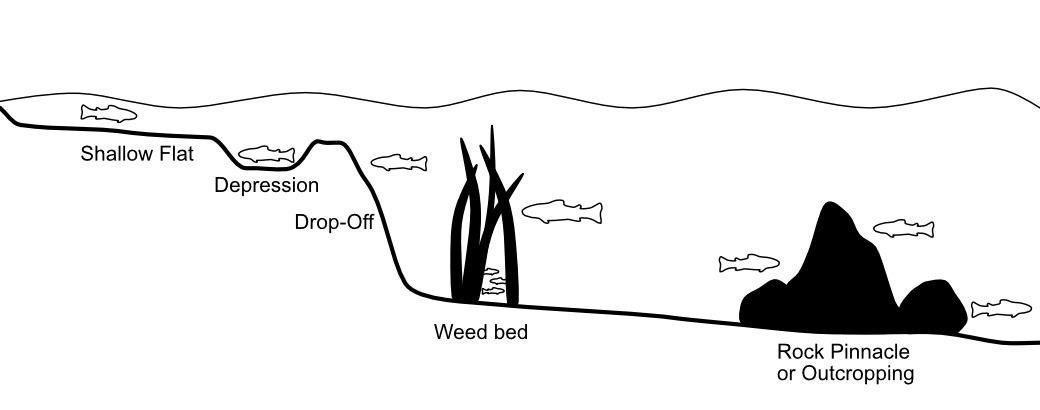
Feeding zones are areas where trout go to feed, they may not be ideal temperature for the fish, but they are tolerable for the reward. These zones can be as simple as the side of the lake the wind is blowing towards, as this will push the bugs and the fish will follow. More specifically, these zones will be areas with some form of structure such as weed beds, drop offs, rock outcroppings/pinnacles, depressions, and flats. The one thing all of these forms of structure have are food.
Weed Beds
Weed beds are great feeding zones for fish as the foliage is home to so many aquatic insects. Another advantage to weed beds is that they offer fish a place to hide. Small fish can easily hide within the foliage, but that also makes it an ideal hunting ground for predatory fish. When fishing in weedy areas, focus along the edges where fish will cruise. Getting the right depth is key here as to not spend the day picking vegetation off of your flies.
Drop Offs
A drop off is any part of the lake, pond, or reservoir in which the lake gets deep quickly. This type of structure allows a fish to quickly change feeding and comfort zones, while staying close to the bottom for protection. Consider fishing drop-offs with sink tip lines to cover as much of the drop off as possible and expect a hooked fish to dive deeper once hooked.
Remember that a drop off might be a small one that merely creates a depression in the bottom where a fish can hide and ambush its prey from below.
Structure
While weed beds and drop offs are considered a type of structure, this term is also used more specifically in regards to rocks, log piles, drowned trees, etc. A rock pinnacle, submerged boulders and similar structural differences will often be places of congregation for baitfish. Those baitfish will attract the bigger, predatory fish.
Flats
A section of Stillwater where the water is relatively shallow and void of structure will not usually be places that fish spend their time. Like a saltwater flat, the fish don’t live there, they just come in to feed, which is why these areas are perfect for the angler.
These flats will be ideal zones for different insects and bottom dwelling creatures such as crayfish. During a hatch, fish will swim these flats for feeding opportunities making for some fun fishing opportunities as well. Get familiar with the various sources of food in these flats and focus on being there at the right time.
